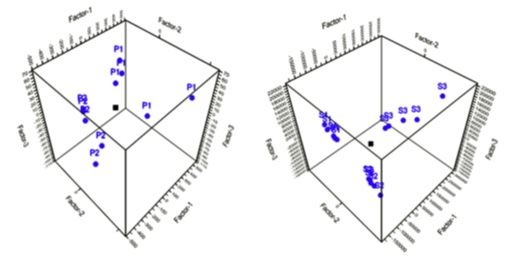Analysis of Environmental Context using Multivariate Techniques
DOI:
https://doi.org/10.31033/abjar.2.1.5Keywords:
techniques, environmental, spectroscopy, microplasma, chemometricAbstract
Under ideal analysis settings, the measurement of emission from laser-induced plasma offers a unique capacity for quantifying the major and minor elements present in any kind of sample. Chemometric techniques are extremely efficient and trustworthy tools for determining the quantities of several components in complicated matrices. For the investigation of environmental reference materials, the viability of laser-induced breakdown spectroscopy (LIBS) in conjunction with multivariate analysis (RMs) was examined. Several (Certified/Standard) References Materials of plant and soil origin were examined using LIBS in the current work, and the presence of Al, Ca, Mg, Fe, K, Mn, and Si was detected in the LIBS spectra of these materials. Using the LIBS spectral data, partial least square regression and partial least square discriminant analysis were used as multivariate statistical techniques for the quantitative study of the constituent elements. To verify the accuracy of the calibration models, the concentrations of the various components in test samples were predicted using the calibration models, and the predicted concentrations were then compared to the certified concentrations. The results of two RMs by LIBS were also compared using the non-destructive analytical technique known as Instrumental Neutron Activation Analysis (INAA), which makes use of high-flux reactor neutrons and high-resolution gamma-ray spectroscopy.
Downloads
References
N.S. Rajurkar, & M.M. Damame. (1997). Elemental analysis of some herbal plants using in the treatment of cardiovascular diseases by NAA and AAS. J. Radio Anal. Nucl. Chem., 77e80.
C.G. Ryan. (2000). Quantitative trace element imaging using PIXE and the nuclear microscope. Int. J. Imaging Syst. Technol. 11, 219e230.
Jie Wang, Tetsuya Nakazato, Kinya Sakanishi, Osamu Yamada, Hiroaki Tao, & Ikuo Saito. (2004). Microwave digestion with HNO3/H2O2 mixture at high temperatures for determination of trace elements in coal by ICP-OES and ICP-MS. Anal. Chim. Acta, 514(2004), 115e124.
N. Civici, Sh. Gjongecaj, F. Stamati, T. Dilo, E. Pavlidou, E.K. Polychroniadis, & Z. Smit. (2007). Compositional study of IIIrd century BC silver coins from Kreshpan hoard (Albania) using EDXRF spectrometry. Nucl. Instrum. Methods Phys. Res., B 258, 414e420.
Sarah C. Jantzi, & Jose R. Almirall. (2011). Characterization and forensic analysis of soil samples using laser-induced breakdown spectroscopy (LIBS). Anal. Bioanal. Chem., 400, 3341e3351.
Gulab Singh Maurya, Aradhana Jyotsana, Rohit Kumar, Ajai Kumar, & A.K. Rai. (2014). Analysis of deposited impurity material on the surface of the optical window of the Tokamak using LIBS. Phys. Scr., 89, 75601.
Rohit Kumar, Awadhesh K. Rai, Devanathan Alamelu, & Suresh K. Aggarwal. (2013). Monitoring of toxic elements present in sludge of industrial waste using CFLIBS. Environ. Monit. Assess., 185, 171e180.
Gabriel Gustinelli Arantes de Carvalho, Javier Moros, Dario Santos Jr., Francisco Jose Krug, & J. Javier Laserna. (2015). Direct determination of the nutrient profile in plant materials by femtosecond laser-induced breakdown spectroscopy. Anal. Chim. Acta, 876, 26e38.
Jennifer L. Gottfried, Russell S. Harmon Jr., Frank C. De Lucia, & Andrzej W. Miziolek.(2009). Multivariate analysis of laser-induced breakdown spectroscopy chemical signatures for geomaterial classification. Spectrochim Acta Part B, 64, 1009e1019.
K. Ayyalasomayajula, Vivek Dikshit, Fang Yu Yueh, Jagdish P. Singh, & Laura T. Smith. (2011). Quantitative analysis of slurry sample by laser-induced breakdown spectroscopy. Anal. Bioanal. Chem., 400, 3315e3322.
Jie Feng, Zhe Wang, Logan West, Zheng Li, & Weidou Ni. (2011). A PLS model based on dominant factor for coal analysis using laser-induced breakdown spectroscopy. Anal. Bioanal. Chem., 400, 3261e3271.

Downloads
Published
How to Cite
Issue
Section
ARK
License
Copyright (c) 2023 Rohit Sikdar

This work is licensed under a Creative Commons Attribution 4.0 International License.
Research Articles in 'Applied Science and Biotechnology Journal for Advanced Research' are Open Access articles published under the Creative Commons CC BY License Creative Commons Attribution 4.0 International License http://creativecommons.org/licenses/by/4.0/. This license allows you to share – copy and redistribute the material in any medium or format. Adapt – remix, transform, and build upon the material for any purpose, even commercially.










